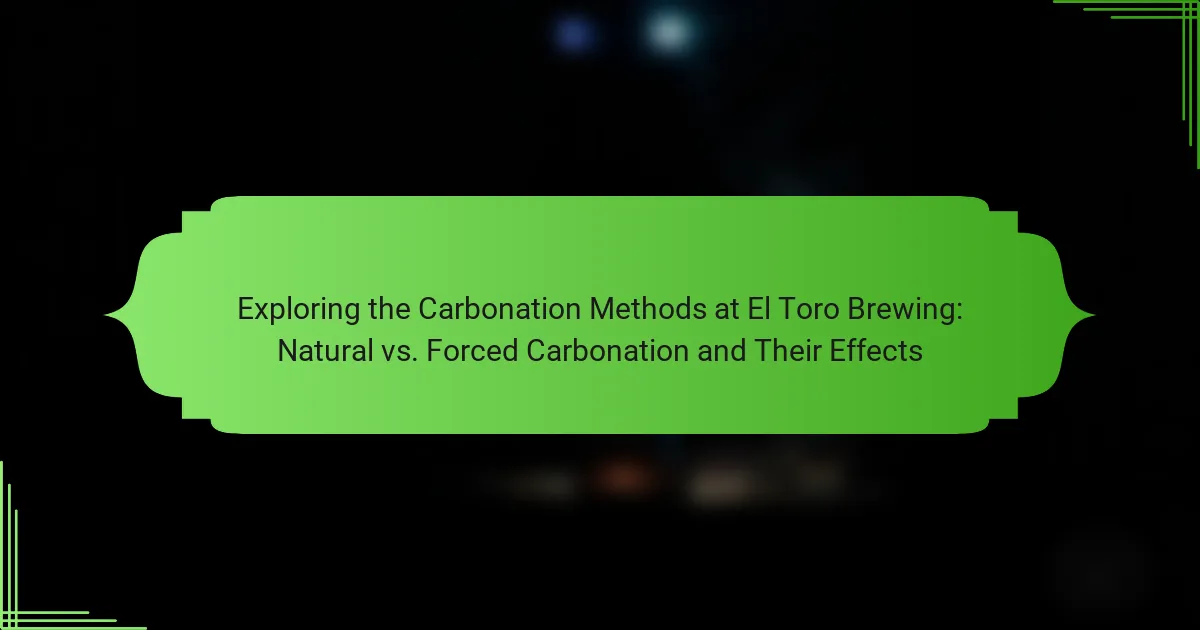Hops are a fundamental ingredient in El Toro Brewing, providing essential bitterness, flavor, and aroma to their beers. Different hop varieties contribute unique characteristics, such as floral, citrus, or pine notes, while balancing the sweetness of the malt. The bitterness of hops is quantified using International Bitterness Units (IBUs), which El Toro Brewing carefully manages to achieve the desired flavor profile. Additionally, the essential oils in hops enhance the aroma, making the beer more enjoyable. This article explores the significance of hops in El Toro Brewing, including the various hop types, their bitterness levels, and their contributions to the overall sensory experience of the beer.

What Role Do Hops Play in El Toro Brewing?
Hops play a crucial role in El Toro Brewing by providing bitterness, flavor, and aroma to the beer. They are essential for balancing the sweetness of the malt. Different hop varieties contribute unique characteristics to each brew. For instance, some hops impart floral notes, while others add citrus or pine flavors. The bitterness level of hops is measured in International Bitterness Units (IBUs). El Toro Brewing carefully selects hops to achieve desired bitterness levels in their beers. Additionally, hops contain essential oils that enhance aroma, making the beer more enjoyable. The combination of these factors makes hops a fundamental ingredient in El Toro Brewing’s recipes.
How Do Different Varieties of Hops Influence Beer Flavor?
Different varieties of hops significantly influence beer flavor. Hops contribute bitterness, aroma, and flavor profiles to beer. Each hop variety has unique characteristics that affect the final taste. For example, Cascade hops impart citrus and floral notes. In contrast, Saaz hops provide earthy and spicy flavors. The alpha acid content of hops determines the level of bitterness. Higher alpha acid hops create more bitterness, while lower alpha acid varieties contribute less. Additionally, the timing of hop addition during brewing affects flavor extraction. Early additions enhance bitterness, while late additions boost aroma and flavor. Studies indicate that the choice of hop variety can alter beer’s overall sensory profile.
What Are the Most Common Hops Varieties Used in El Toro Brewing?
El Toro Brewing commonly uses Citra, Cascade, and Centennial hops. Citra hops are known for their strong citrus and tropical fruit flavors. Cascade hops provide floral and grapefruit notes, enhancing aroma and bitterness. Centennial hops balance the profile with a combination of floral and citrus characteristics. These hops contribute significantly to the overall flavor and aroma of El Toro’s beers. Their selection aligns with the brewery’s commitment to quality and distinctive taste.
How Does Each Hop Variety Contribute to the Overall Taste Profile?
Each hop variety contributes distinct flavors and aromas to the overall taste profile of beer. For example, Cascade hops impart citrus and floral notes, enhancing the beer’s freshness. Citra hops are known for their strong tropical fruit flavors, particularly grapefruit and lime. Simcoe hops add a complex profile with pine, earth, and citrus characteristics. Amarillo hops provide orange and floral notes, adding depth to the flavor.
Nugget hops typically bring a spicy and herbal profile, contributing to the bitterness. Saaz hops are known for their mild and earthy qualities, often used in lagers. Each variety’s unique attributes influence the final taste experience. The combination of these hops creates a balanced and layered flavor profile in the beer.
What Are the Bitterness Levels Associated with Hops?
Hops have varying bitterness levels measured in International Bitterness Units (IBUs). The bitterness from hops typically ranges from 5 to over 100 IBUs. Lower bitterness levels, around 5 to 20 IBUs, are common in lighter beers. Medium bitterness levels, from 20 to 40 IBUs, are often found in pale ales. Higher bitterness levels, exceeding 40 IBUs, are characteristic of IPAs and double IPAs. The specific variety of hops used influences the bitterness level. For example, varieties like Chinook and Columbus can impart higher bitterness. Conversely, varieties like Saaz and Hallertau provide a milder bitterness. This range of bitterness levels contributes to the overall flavor profile of the beer.
How Is Bitterness Measured in Beer?
Bitterness in beer is measured using the International Bitterness Units (IBU) scale. The IBU scale quantifies the concentration of bitter compounds, primarily iso-alpha acids, derived from hops. A higher IBU value indicates a more bitter beer. For example, a beer with 10 IBUs is considered low in bitterness, while one with 80 IBUs is very bitter. The measurement process involves a spectrophotometric analysis of the beer sample. This method assesses the absorbance of light at specific wavelengths. The results provide a precise measurement of the bitterness level. Generally, beers with higher hop content will have elevated IBU ratings. The IBU scale helps brewers and consumers understand the bitterness profile of different beers.
What Factors Affect the Bitterness Levels of Different Hops?
The bitterness levels of different hops are primarily affected by the alpha acid content. Alpha acids are the compounds responsible for bitterness in beer. The specific variety of hop determines its alpha acid percentage. Environmental factors such as soil composition, climate, and growing conditions also influence alpha acid levels. Harvest timing can impact the bitterness as well. Hops picked at optimal ripeness yield higher bitterness. Additionally, the method of hop utilization during brewing affects the extraction of bitterness. Boiling time and temperature further influence how much bitterness is imparted to the beer.
What Aroma Contributions Do Hops Make to Beer?
Hops contribute a variety of aromas to beer, enhancing its overall flavor profile. Common hop aromas include floral, citrus, pine, and herbal notes. These characteristics are derived from essential oils present in the hop cones. Different hop varieties impart distinct aromatic qualities. For example, Cascade hops are known for their grapefruit and floral notes. In contrast, Citra hops provide tropical fruit aromas. The timing of hop addition during brewing affects aroma intensity. Late additions maximize aroma retention in the final product. Research shows that hops can significantly influence consumer preferences based on aroma. This highlights their crucial role in crafting appealing beers.
How Do Hops Enhance the Aroma of El Toro Brews?
Hops enhance the aroma of El Toro brews by imparting a range of fragrant compounds. These compounds include essential oils that contribute floral, citrus, and herbal notes. The specific hop varieties used in El Toro brewing play a crucial role in this aromatic profile. For instance, hops like Citra and Amarillo are known for their strong citrus aromas. When added during the brewing process, hops release these oils, enriching the beer’s aroma. This aromatic enhancement is vital for creating a well-rounded flavor experience. Research shows that the timing of hop addition also affects aroma intensity. Late additions during boiling or dry hopping maximize aroma retention. Thus, hops are essential for achieving the desired aromatic quality in El Toro brews.
What Are the Key Aromatic Compounds Found in Various Hop Varieties?
Key aromatic compounds found in various hop varieties include myrcene, humulene, and caryophyllene. Myrcene is known for its fruity and herbal notes, commonly present in many hop types. Humulene contributes earthy and woody aromas, making it distinct among hops. Caryophyllene adds a spicy character, often associated with certain varieties. Other notable compounds include linalool, which imparts floral scents, and geraniol, known for its sweet, rose-like aroma. These compounds vary in concentration across different hop varieties, influencing the overall aroma profile of the beer. The aromatic complexity is crucial for brewers in crafting unique flavors and scents in their products.
How Do Hops Impact the Brewing Process at El Toro?
Hops significantly influence the brewing process at El Toro. They contribute bitterness, aroma, and flavor to the beer. The bitterness balances the sweetness of the malt. This is crucial for achieving the desired taste profile. Different hop varieties offer unique aromatic qualities. For instance, citrusy hops enhance freshness in pale ales. The timing of hop additions affects the final flavor. Early additions impart more bitterness, while later additions boost aroma. Hops also have preservative qualities, extending the beer’s shelf life. This multifaceted role makes hops essential in El Toro’s brewing process.
What Techniques Does El Toro Use to Maximize Hop Flavor and Aroma?
El Toro maximizes hop flavor and aroma through various techniques. They utilize late hopping, which adds hops during the final stages of brewing. This method preserves volatile oils that contribute to aroma. Additionally, El Toro employs dry hopping, adding hops post-fermentation. This technique enhances the hop character without increasing bitterness. They also practice hop selection, choosing specific varieties known for their aromatic properties. Furthermore, El Toro controls fermentation temperatures to maintain hop integrity. These methods collectively ensure a robust hop profile in their beers.
What Best Practices Should Homebrewers Follow When Using Hops?
Homebrewers should use fresh hops for optimal flavor and aroma. Fresh hops retain essential oils that contribute to the beer’s characteristics. Store hops in a cool, dark place to maintain their potency. Measure hops accurately to achieve desired bitterness levels. Timing of hop additions is crucial; early additions enhance bitterness, while late additions boost aroma. Experiment with different hop varieties to discover unique flavor profiles. Finally, consider dry hopping during fermentation for enhanced aroma without increasing bitterness. These practices ensure a balanced and flavorful final product.
The main entity of this article is hops, a crucial ingredient in El Toro Brewing that contributes bitterness, flavor, and aroma to their beers. The article provides an overview of various hop varieties used in El Toro Brewing, detailing how each type influences the overall taste profile and bitterness levels measured in International Bitterness Units (IBUs). It also explores the aromatic compounds found in hops and their impact on the brewing process, including techniques employed by El Toro to maximize hop flavor and aroma. Additionally, best practices for homebrewers regarding hop usage are discussed to enhance their brewing outcomes.


